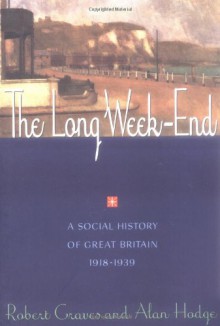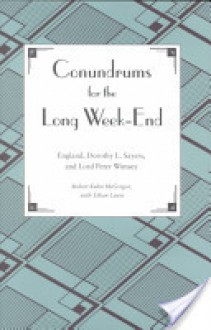 For anyone interested in the era this book is essential
For anyone interested in the era this book is essential"[b:The Long Week End: A Social History of Great Britain, 1918-1939|52254|The Long Week End A Social History of Great Britain, 1918-1939|Robert Graves|http://d.gr-assets.com/books/1347523056s/52254.jpg|3020623]" was written by novelist Robert Graves (author of the excellent First World War memoir "[b:Goodbye to All That|55428|Goodbye to All That|Robert Graves|http://d.gr-assets.com/books/1348218570s/55428.jpg|1701023]"), and Alan Hodge.
I am fascinated by the first fifty years of the twentieth century and read a lot of fiction and non-fiction from this era. My focus tends to be on Europe, and in particular the UK, and so I was particularly interested in reading this "social history of Great Britain" during the peace that endured between World War One and World War Two.
The book was first published in 1940 and so is written without the knowledge of the outcome of World War Two.
That this book contains an alternate, idiosyncratic and personal history of Britain between World War One and World War Two, becomes very apparent when the reader arrives at the chapter headings. Here's a list of the 26 chapters contained within this book:
Armistice, 1918
Revolution Averted, 1919
Women
Reading Matter
Post-War Politics
Various Conquests
Sex
Amusements
Screen and Stage
Revolution Again Averted, 1926
Domestic Life
Art, Literature, and Religion
Education and Ethics
Sport and Controversy
The Depression, 1930
Pacifism, Nudism, Hiking
The Days Of The Loch Ness Monster
Recovery, 1935
The Days of Non-Intervention
'The Deepening Twilight of Barbarism'
Three Kings in One Year
Keeping Fit, and Doing The Lambeth Walk
Social Consciences
'Markets Close Firmer'
Still At Peace
Rain Stops Play, 1939
Furthermore, the topics covered within these chapters tend to meander about, and the authors touch on all manner of disparate elements of life in Britain during this era. This means the book is chock full of fascinating trivia and ephemera, however it also means the book can feel unstructured, kaleidoscopic, and - on occasion - somewhat overwhelming.
I suspect a book written now, about this era, might deem a lot of the information in this book superficial, insignificant or irrelevant. Every page contains a curious insight, or remarkable fact, or piece of period detail, that really illuminates the period. Based on my knowledge (which is far from comprehensive), this book appears to really capture the spirit of the years between 1918 and 1939.
Reading the book brought up parallels to modern times, showing that the more things change the more they stay the same. Moralists attacked the immorality of the times, popular music, books and movies were blamed for the lowering of the standards of decency and culture, the older generation decried the lax mores of the young, the high brows decried the intrusion of American low-brow culture. Sound familiar?
I found the extensive quotes from newspapers illuminating, particularly leading up to the declaration of war.
For anyone interested in the era this book is essential: providing a fascinating alternate history of Britain between the wars, and one that focuses as much on the general public, the mood of the nation, the fashion and trends, as the bigger picture.



